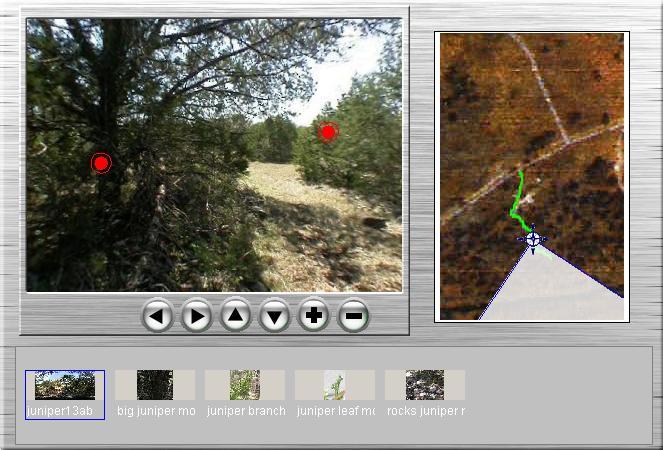Nature Trail Stop 4: Juniper Thicket
Ashe junipers (scientific name: Juniperus ashei) are commonly called “Mountain Cedars” in the central Texas region. However, they are not Cedars at all; they belong to the Cypress family. Ashe junipers are well known in the central Texas region because of their effects on allergies, which is referred to as “Cedar Fever.” The ashe junipers are also known for the habitat they provide for the Golden Cheek Warbler, an endangered migratory bird that uses materials from ashe junipers to build nests.
The thicket in the tour below shows a large ashe juniper on the left hand side of the path. You can see the plant more closely by clicking on the hotspot. The size of this plant indicates that this area has not had a fire for many years. The savannas at Freeman Ranch and in the Edward’s Plateau region have been maintained naturally for hundreds of years by climate, occasional grazing of bison and antelope, and frequent wildfires.
Over the last 200 years, however, two of these three factors have changed. Areas of the Edward’s Plateau, including Freeman Ranch, have experienced an increase in the amount of grazing animals. European settlers have brought cattle, goats, and sheep to their ranches and allowed them to graze extensively in some areas. As we shall see at the next stop, this action is thought to have affected the type of grasses in the Edward’s Plateau. The other change is a decrease in the number of wildfires, which has been caused by humans suppressing these fires.
Because ashe junipers are not tolerant of fires as the live oaks are, the Junipers have flourished during this time of suppressed fires. Today, the junipers continue to invade areas that were once prominent with grassland and isolated clusters of trees. This increase in the number and area of ashe junipers has begun transforming the Edward’s Plateau region, including the Freeman Ranch, from a savanna to a woodland ecosystem.
Ashe Juniper: Tolerances and Limitations
Ashe junipers are very tough plants, being able to survive harsh environments. They are tolerant to drought, rocky soils, steep slopes and cliffs, full sun, and cold temperatures. In the tour above, one of the hotspots shows you a close-up picture of the rocky ground at this site. It illustrates what type of environment the junipers can thrive in.
Looking at the tour again, closely examine a branch of one of the ashe junipers using the hotspot link. Notice the shape of the leaf – it is a needleleaf. Needleleaves conserve moisture for the plant because they reduce the surface area through which moisture can evaporate from the plant to the air. (Note: plants lose moisture to the atmosphere through their leaves). The ashe junipers do, however, require well-drained land just like the live oaks.
Let’s go on to our last stop, Savanna Sanctuary. Be sure you have recorded and classified ashe juniper in your species inventory table and have completed the notes in this section before proceeding to the last stop.
